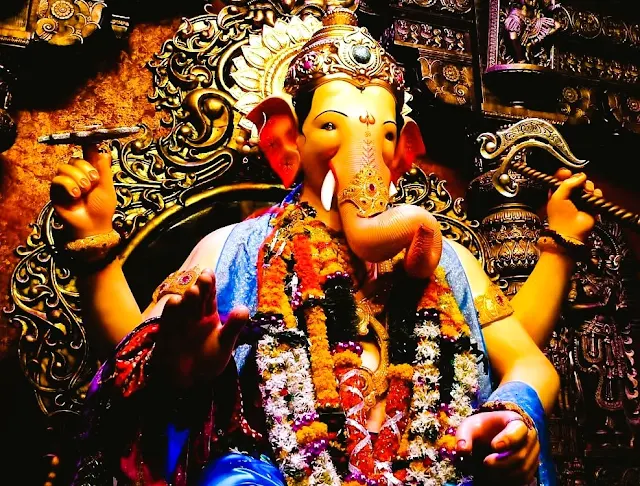The Complete and Detailed History of
Lalbagcha Raja: From Ancient Roots to Modern Celebrations
Introduction: The Significance of Lalbagcha Raja
Lalbagcha Raja, also known as Lalbag
Ganesh, is one of Mumbai’s most revered and grandest Sarvajanik
Ganeshotsav celebrations. Located in Parel’s Lalbag area,
this festival attracts millions of devotees annually. But how did this
tradition begin? What makes it so special?
This
in-depth guide explores:
✔ Ancient
origins of Ganesh Chaturthi in India
✔ The
birth of Lalbagcha Raja in 1934
✔ Key
historical events that shaped its growth
✔ The
socio-political impact of Lalbag Ganesh
✔ Modern-day
celebrations and records
Ancient
Roots: The Historical Context of Ganesh Chaturthi in India
Before
diving into Lalbagcha Raja’s history, we must understand the broader
history of Ganesh Chaturthi in India.
A. Early
Mentions of Ganesh Worship
- Ganesh
worship dates back to 4th-5th century CE, with references in
the Mudgala Purana and Ganesha Purana.
- The Maratha
Empire (17th-18th century) popularized public Ganesh festivals
under Chhatrapati Shivaji Maharaj.
B.
Revival by Lokmanya Tilak (1893)
- Pre-1893: Ganesh Chaturthi was mostly a private
family festival.
- 1893: Lokmanya Bal
Gangadhar Tilak transformed it into a mass public event to
unite Indians against British rule.
- Impact: This led to the rise of Sarvajanik
(public) Ganeshotsav mandals across Maharashtra.
The
Birth of Lalbagcha Raja (1934)
A. The
Founding of Lalbag Sarvajanik Ganeshotsav Mandal
- Year: 1934 (same
year as Lalbaugcha Raja).
- Founders: A group of mill
workers and local residents in Parel’s Lalbag area.
- Reason: To foster unity among
workers and seek blessings for prosperity.
B. Early
Celebrations (1930s-1940s)
- Idol
Size:
Initially small (3-4 feet) and made of shadu clay.
- Pandal: A simple bamboo-and-cloth
structure.
- Key
Feature: Focus
on community participation rather than grandeur.
C. The
First Major Turning Point (1950s)
- Post-Independence
(1947), the
festival grew in scale.
- 1950s: Introduction of themed
decorations and bigger idols (8-10 feet).
- Processions: Started attracting local
politicians and celebrities.
The
Golden Era: Lalbagcha Raja’s Rise to Fame (1960s-1990s)
A. The
Miracle Stories & Growing Devotion
- 1965: A devotee claimed his terminally
ill child was cured after praying to Lalbagcha Raja.
- 1970s: Stories of wish
fulfillment spread, increasing footfall.
B.
Political & Celebrity Visits
- 1980s: Bal Thackeray (Shiv
Sena) and Sharad Pawar (NCP) began visiting.
- 1990s: Bollywood stars like Amitabh
Bachchan and Sachin Tendulkar paid respects.
C. The
Competition with Lalbaugcha Raja
- Lalbaugcha
Raja (also est. 1934) became
a rival in terms of fame.
- Key
Differences:
- Lalbagcha
Raja: Known
for miracles and spiritual significance.
- Lalbaugcha
Raja: Known
for VIP visits and media coverage.
Modern-Day
Celebrations (2000s-Present)
A.
Record-Breaking Idols & Themes
- 2005: First 20-foot-tall
eco-friendly idol.
- 2010: Theme based on "Save
the Girl Child".
- 2021: Digital darshan introduced
due to COVID-19.
B.
Visitor Statistics & Economic Impact
- Annual
Visitors: 1.5
to 2 million.
- Donations: Over ₹5 crores collected
yearly for charity.
- Employment: Generates temporary
jobs for 5,000+ workers.
C.
Social Initiatives by Lalbag Mandal
- Free
Medical Camps (since
1982).
- Scholarships
for underprivileged students.
- Disaster
Relief Funds (e.g.,
2005 floods, 2020 pandemic).
Frequently
Asked Questions (FAQs) with Historical Insights
Q1.
Why is Lalbagcha Raja called the "King of Lalbag"?
- The
title "Raja" (King) symbolizes its dominance in
Mumbai’s Ganesh festival scene.
Q2.
How is Lalbagcha Raja different from other Ganesh pandals?
- It’s
one of the oldest (since 1934) and focuses on social
causes.
Q3.
What was the most controversial moment in Lalbag Ganesh history?
- 1992: A dispute between two
factions over donation management led to police
intervention.
Q4.
Has Lalbagcha Raja ever been featured in films?
- Yes!
Scenes from "Satyamev Jayate" (2018) were shot
here.
Q5.
What is the future of Lalbag Ganesh?
- Plans
for AI-powered virtual darshans and bigger
eco-friendly idols.
Why
Lalbagcha Raja Remains Mumbai’s Pride
From
its humble beginnings in 1934 to becoming a global
attraction, Lalbagcha Raja’s journey is a testament to faith,
culture, and community spirit. Whether you’re a devotee or a history
enthusiast, this festival offers a deep dive into Mumbai’s heritage.
Did you know any of these facts? Share your thoughts in the comments! 🚩🙏



.png)


.jpeg)



.png)



0 Comments